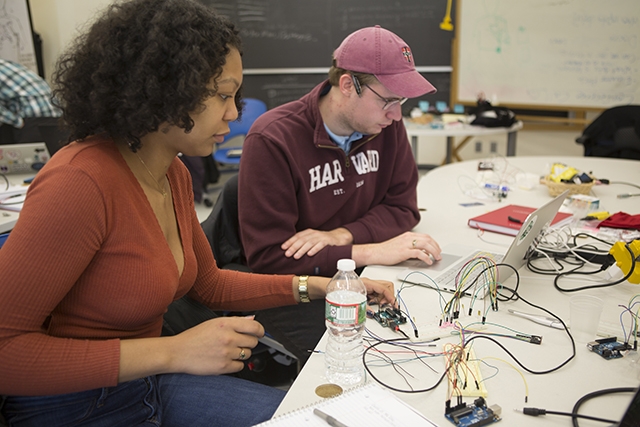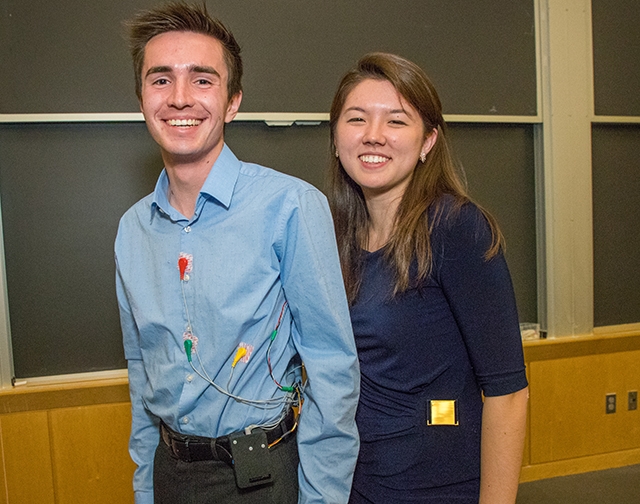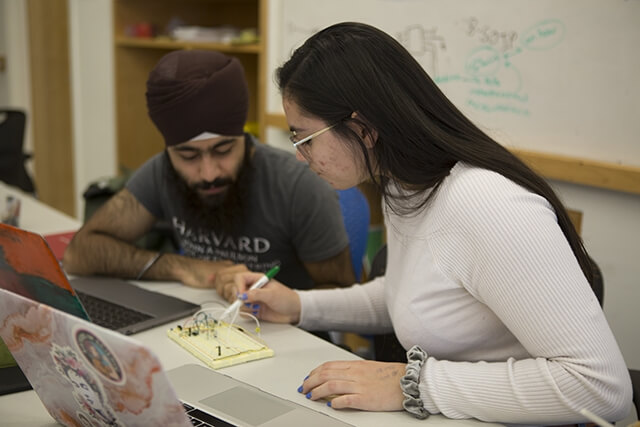News
Every two minutes, a child is diagnosed with cancer. But the likelihood that child will survive the disease is, in many ways, more dependent on geography than the treatment regimen.
Only 20 percent of pediatric cancer patients in lower- and middle-income countries (LMICs) like Bangladesh, Nigeria, and Haiti, will survive, according to the Dana-Farber/Boston Children’s Cancer & Blood Disorders Center’s Global Health Initiative (GHI). This disparity is due in part to a grave a nursing shortage in LMICs—often only one nurse for every 20 patients—that puts the most vulnerable patients at risk.
To help address this widespread problem, a class of Harvard John A. Paulson School of Engineering and Applied Sciences (SEAS) students applied their engineering design skills this fall, partnering with clinicians from GHI. For Engineering Problem Solving and Design Project (ES 96), taught by David Mooney, Robert P. Pinkas Family Professor of Bioengineering, and Samir Mitragotri, Hiller Professor of Bioengineering, students developed a vital monitoring system to help nurses in low-resource countries more quickly identify potential complications of pediatric cancer, like infection and sepsis.
Environmental engineering concentrator Jazmin Simpkins, S.B. ’20, and bioengineering concentrator Nathan Sharpe, work on a temperature sensor prototype. (Photo by Adam Zewe/SEAS Communications)
“Because there are large shortages of nurses in the countries GHI serves, nurses often aren’t able to take a patient’s vital signs more than once every 12 hours, but infection and sepsis have a very tight timeline for intervention,” said project co-lead Michelle Walsh, S.B. ’20, a bioengineering concentrator. “We set out to automate the process, so nurses could be alerted if there are potential signs of infection, even if they can’t be at the patient’s bedside.”
The students targeted sepsis and infection since they are often the most dangerous complications of pediatric cancer treatment, which usually involves chemotherapy that severely weakens a child’s immune system, said project co-lead Jesse Thue, S.B. ’20, an electrical engineering concentrator. For instance, the sepsis mortality rate increases 8 percent every hour treatment is delayed.
Thue and his classmates developed PediaTrack, a wearable device that measures a patient’s body temperature, heart rate, and respiratory rate every 10 minutes. The device transmits information to a database that enables nurses to track a patient’s vital signs remotely and study longitudinal data.
The wearable, which continuously draws readings from electrocardiogram (ECG) leads and a temperature sensor, engages colored LEDs to show a patient’s status.
One of the biggest challenges students faced in creating their device was to design a housing large enough for the many different electronic components that was still comfortable for a child to wear, said Cathy Wang, S.B. ’20, a bioengineering concentrator.
“We considered many different criteria, including range of motion, breathability, wear time, and reliability, all of which contribute to our overall goal of designing something a child can wear without feeling restricted,” she said. “It’s a burden for a child and his or her family to go through the fight against cancer; we want to provide as much support as possible by making the in-hospital processes more comfortable.”
Project co-leads Jesse Thue, S.B. ’20, an electrical engineering concentrator, and Michelle Walsh, S.B. ’20, a bioengineering concentrator, demonstrate the PediaTrack wearable. (Photo by Eliza Grinnell/SEAS Communications)
After the device takes measurements, it transmits and saves data to the software “hub” where patient readings are color coded white, yellow, or red to indicate whether a patient has surpassed safe thresholds for body temperature, heart rate, or respiratory rate.
The software calculates whether the data are outside the normal ranges based on the patient’s age, and then triggers an alarm in the device. Nurses are able to edit temperature, respiration, and heart rate thresholds based on additional factors.
The biggest challenge of developing the temperature sensing components involved incorporating a tiny sensor with different connection types into the prototype’s circuitry, said Nathan Sharp, S.B. ’20, a bioengineering concentrator. After learning how to perform small-scale soldering, he and his teammates designed a small circuit board to serve as an adapter for the sensor chip.
“The most important lesson I learned is just how valuable collaboration across disciplines can be,” he said. “Our class consisted of bioengineers, mechanical engineers, electrical engineers, and environmental engineers, and everyone had an important role to play in the final design.”
The final prototype, which has a battery life of about 40 hours and recharges in four hours, cost $55 to produce, but that price could be driven down with mass production, Thue said.
Aileen Villalpando, S.B. ’20, a bioengineering concentrator, and electrical engineering concentrator Awnit Singh Marta, S.B. ’20, reconstruct an EKG circuit. (Photo by Adam Zewe/SEAS Communications)
Looking forward, the students would like to further improve their sensing components and software, as well as create a mobile app for clinicians and enable integration with a hospital’s electronic patient records system.
“Our solution sits at the intersection of data collection, communication, and interpretation,” said Thue. “It monitors three vital signs that are tailored to infection and sepsis, incorporates continuous monitoring, and tracks longitudinal data that allows clinicians to provide more informed care for patients. We think this device has significant potential.”
Mooney was impressed that the students came up with a creative solution that is also very practical.
“They did a wonderful job of integrating the different areas of engineering to design and build their system, and test it in a series of studies. This work lays the foundation for this device to move toward clinical trial,” he said. “I hope they learned to set high expectations for themselves, as they are clearly capable of successfully meeting big goals. I also hope they learned the importance of teamwork, and that the full engagement of each member of the team is required for success.”
“We were excited to work with Professor Mooney and his class again and see how committed the students were to come up with a technological solution that addresses the survival rates of children with cancer globally,” said GHI Director Irini Albanti. “Collaborating across public health, engineering, and medicine disciplines within our Harvard community will bring us closer to tackle inequities in global pediatric oncology that we wouldn’t be able to solve on our own.”
Topics: Academics, Health / Medicine
Cutting-edge science delivered direct to your inbox.
Join the Harvard SEAS mailing list.





